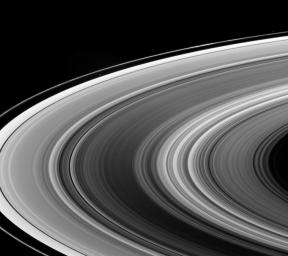This view looks down onto the unlit side of Saturn's ringplane. It nicely shows a near-arm/far-arm brightness asymmetry in the B ring: The near arm of the B ring (in the lower half of the image) is notably darker from this viewing geometry than is the far arm (above).
Imaging scientists believe this to be a manifestation of the reflection of light from the disk of Saturn falling predominantly on the far arm of the rings. (At the time this image was taken, Cassini was more or less on the dark side of the planet.) As the B ring is the thickest part of Saturn's rings, it scatters less sunlight from below, and reflects more Saturn shine from above, than either the A or C rings, making the effect look more dramatic in the B ring.
Two small moons appear in this scene as well: Atlas (32 kilometers, or 20 miles across) is visible above and left of center and outside the A ring; Pandora (84 kilometers, or 52 miles across) can be seen near upper right beyond the F ring. Between the two moons lie multiple clumps of material in the F ring.
The image was taken in visible light with the Cassini spacecraft wide-angle camera on July 25, 2006 at a distance of approximately 1 million kilometers (600,000 miles) from Saturn and at a Sun-Saturn-spacecraft, or phase, angle of 128 degrees. Image scale is 58 kilometers (36 miles) per pixel.
The Cassini-Huygens mission is a cooperative project of NASA, the European Space Agency and the Italian Space Agency. The Jet Propulsion Laboratory, a division of the California Institute of Technology in Pasadena, manages the mission for NASA's Science Mission Directorate, Washington, D.C. The Cassini orbiter and its two onboard cameras were designed, developed and assembled at JPL. The imaging operations center is based at the Space Science Institute in Boulder, Colo.
For more information about the Cassini-Huygens mission visit http://saturn.jpl.nasa.gov/home/index.cfm. The Cassini imaging team homepage is at http://ciclops.org.

 Planetary Data System
Planetary Data System












